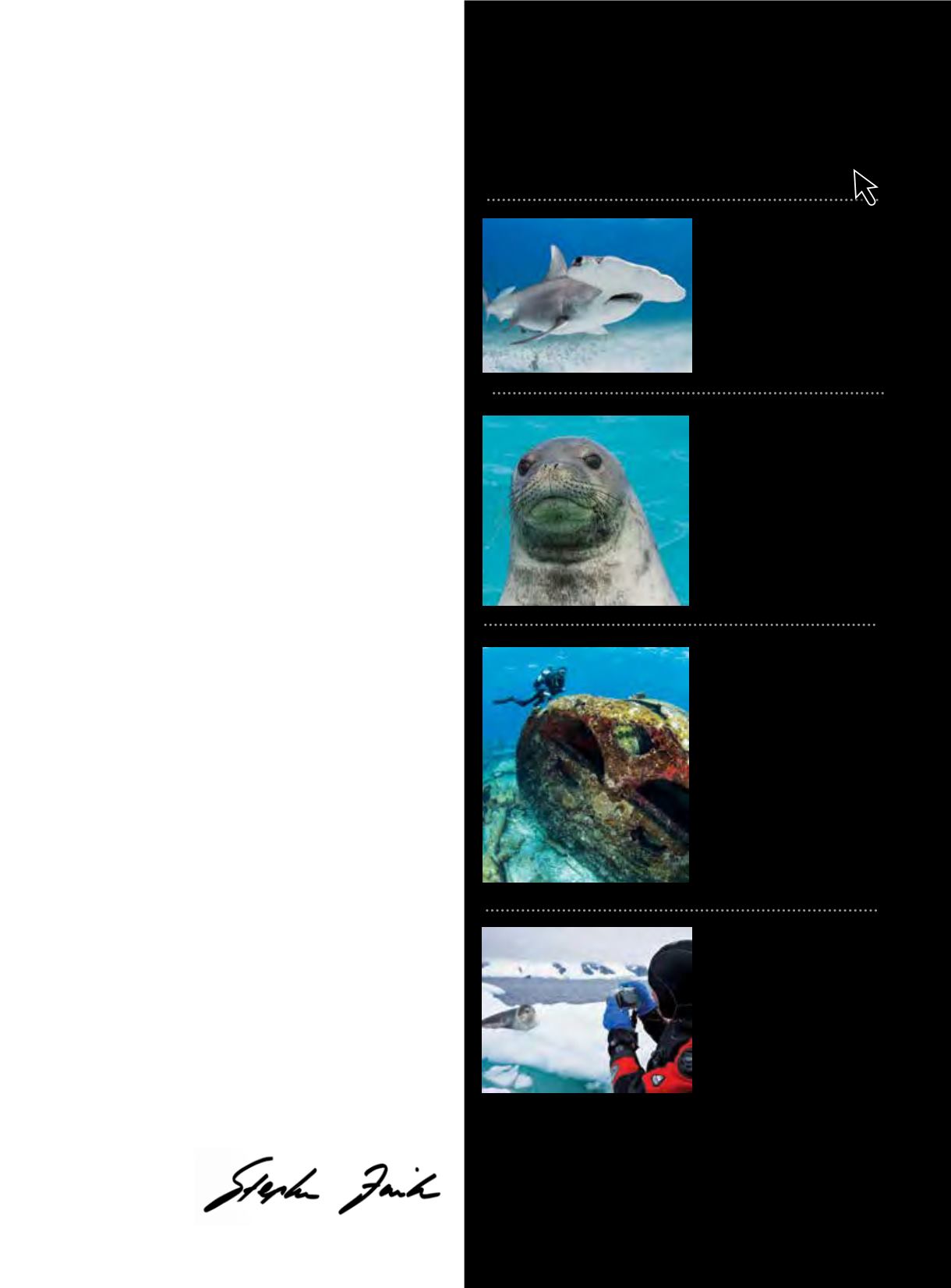
|
11
WHAT’S NEW ON
ALERTDIVER.COM
IMMERSION
RESEARCH
Biologist Austin Gallagher
reports on the current state of
shark populations on Page 20.
Take the plunge with Gallagher
as he dives among oceanic
whitetips in his film Bold.
MONK SEALS
Read “Choosing Extinction” on
Page 108 to learn about the
hazards facing the critically
endangered Hawaiian monk
seal. Then watch National
Geographic’s Monk Seal
Mystery: Northwest Hawaiian
Islands to explore the seals’
world through crittercams.
BEHOLD THE
BAHAMAS
In collaboration with the
Bahamas Ministry of
Tourism, Alert Diver hosted
the Bahamas Underwater
Photo Week in May 2014.
Four shooters documented
Bahamas diving from 10
different islands. Read their
stories on Page 64, and
continue exploring the islands
in the online bonus gallery
A REMOTE
EVACUATION
Read big-animal photographer
Amos Nachoum’s story of his
emergency evacuation from
Antarctica on Page 42. Then
peruse images from his
other expeditions to Earth’s
southern extremes.
ALL THIS AND MUCH MORE AWAIT AT
.
these animals were grazers that kept the reef substrate
clear of algae and available for colonization by coral.
I didn’t think about the storms that would damage
the reef or the possibility that clumsy and uneducated
divers were breaking these fragile corals. Whatever
the contributing factors, the coral gardens of South
Carysfort were gone before I really noticed what was
happening. In other areas of the Key Largo reef tract
there is considerable new coral growth (including fresh
elkhorn growth on North Carysfort), but the wide-angle
vistas I’d envisioned in my mind’s eye on that particular
reef were never to be.
That was my first and most enduring epiphany
about the fragility of the coral reef. It is also part of the
reason I was so excited to see beautifully intact elkhorn
corals off the Abacos when I was shooting for Bahamas
Underwater Photo Week (see Page 64). I’m certainly
more appreciative now when I have the privilege of
visiting a pristine reef, and I try to make the images count.
With privilege comes responsibility. Back in the day
I remember having a conscious debate with myself as
I found a particularly inviting subject surrounded by
fragile corals. Is my photograph important enough to
justify breaking just a little coral to get to the sweet
spot for the perfect angle? After all, underwater
photography requires proximity, and proximity invites
contact. The correct answer is obviously no. No
photograph is worth breaking coral or damaging the
reef. The coral reef is a shared resource, and no diver
has the right to purposely inflict damage. As visual
communicators it is our obligation to interact with
the coral reef in a benign manner and to photograph
subjects in such a way that we send the right message.
On a recent night dive in Indonesia I heard my guide
chirping through his regulator and saw him excitedly
pointing at a puffed-up pufferfish. My instincts kicked in,
and I took the photo, but I shot only one before I caught
myself. I had another conscious debate with myself. Had
I ever seen a pufferfish in the water column that was
inflated without some diver making it so? No. Was it
likely the guide did it and then swam it over to me? Yes.
Would me excitedly taking numerous pictures of the
obviously alarmed pufferfish communicate to him that it
was OK to do this for his guests next week? For sure.
We had a quiet chat on the boat on the way home
during which I explained why I couldn’t take that shot.
Sometimes as visual communicators we have to just
say no. The shot is not worth it, and the message is
just wrong.
AD
AUSTIN GALLAGHER
DOUG PERRINE
STEPHEN FRINK
AMOS NACHOUM


